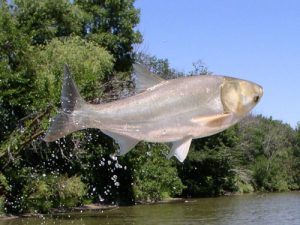In May, the Asian Carp Regional Coordinating Committee (ACRCC) released its 2011 Asian Carp Monitoring and Rapid Response Plan (MRRP), outlining an aggressive set of actions to track and remove Asian carp in the Upper Illinois River and the Chicago Area Waterway System (CAWS) to prevent this invasive species from establishing in the Great Lakes.
In 2010, Federal and state partners executed an aggressive, coordinated Asian carp monitoring and sampling strategy, dedicating more than 16,000 hours to surveying and removing Asian carp in more than 200 miles of Illinois waterway.
On-the-ground actions ranged from cutting-edge scientific analysis of water samples for Asian carp DNA to intensive use of traditional fishing methods such as electrofishing and netting.
These actions were part of a comprehensive, multi-tiered Asian Carp Control Strategy Framework first released in May 2010. The 2011 MRRP summarizes the monitoring results from 2010, continues and intensifies these monitoring and sampling actions to take advantage of new technology, tools and understanding of this invasive species, and outlines a strategy for rapid response in the event an Asian carp is found above the barrier system in the CAWS.
The 2011 MRRP, which represents an estimated $7 million Federal investment, is designed with the flexibility to respond to new threats. Project plans can be categorized geographically or other factors.
The threat from Asian carp has generated an urgent and committed government response. In addition to aggressive monitoring and sampling, the ACRCC has proactively worked to contain Asian carp in the CAWS by constructing a third electric barrier in the Chicago Sanitary and Ship Canal, constructing a 13-mile physical barrier along the Des Plaines River to prevent fish bypass during flooding, and conducting research focused on control technology and methods that can be tailored and applied to control Asian carp.
The MRRP targets the Upper Illinois River and Chicago Area Waterway System, the Asian carp pathway of greatest concern.
In addition, the ACRCC released an “Other Pathways” study in December 2010 to identify and close off other potential aquatic pathways where Asian carp could enter the Great Lakes basin; constructed a 1,500 foot fish barrier fence at Eagle Marsh in Indiana to prevent fish from migrating from the Wabash River into the Great Lakes watershed; and continues to develop the Great Lakes Mississippi River Interbasin Study to assess threats throughout the basin, including in the CAWS.
The ACRCC is led by the White House Council on Environmental Quality and includes the U.S. Army Corps of Engineers, U.S. Coast Guard, U.S. Fish and Wildlife Service, U.S. Geological Survey, U.S. Environmental Protection Agency, the National Oceanic and Atmospheric Administration, U.S. Department of Transportation and all eight Great Lakes states, as well as the Great Lakes Fishery Commission, the Metropolitan Water Reclamation District of Greater Chicago, and the City of Chicago.
For more information on the 2011 MRRP, 2010 actions, or to view the entire 2011 Asian Carp Control Strategy Framework, visit: www.asiancarp.org
source: Illinois DNR
